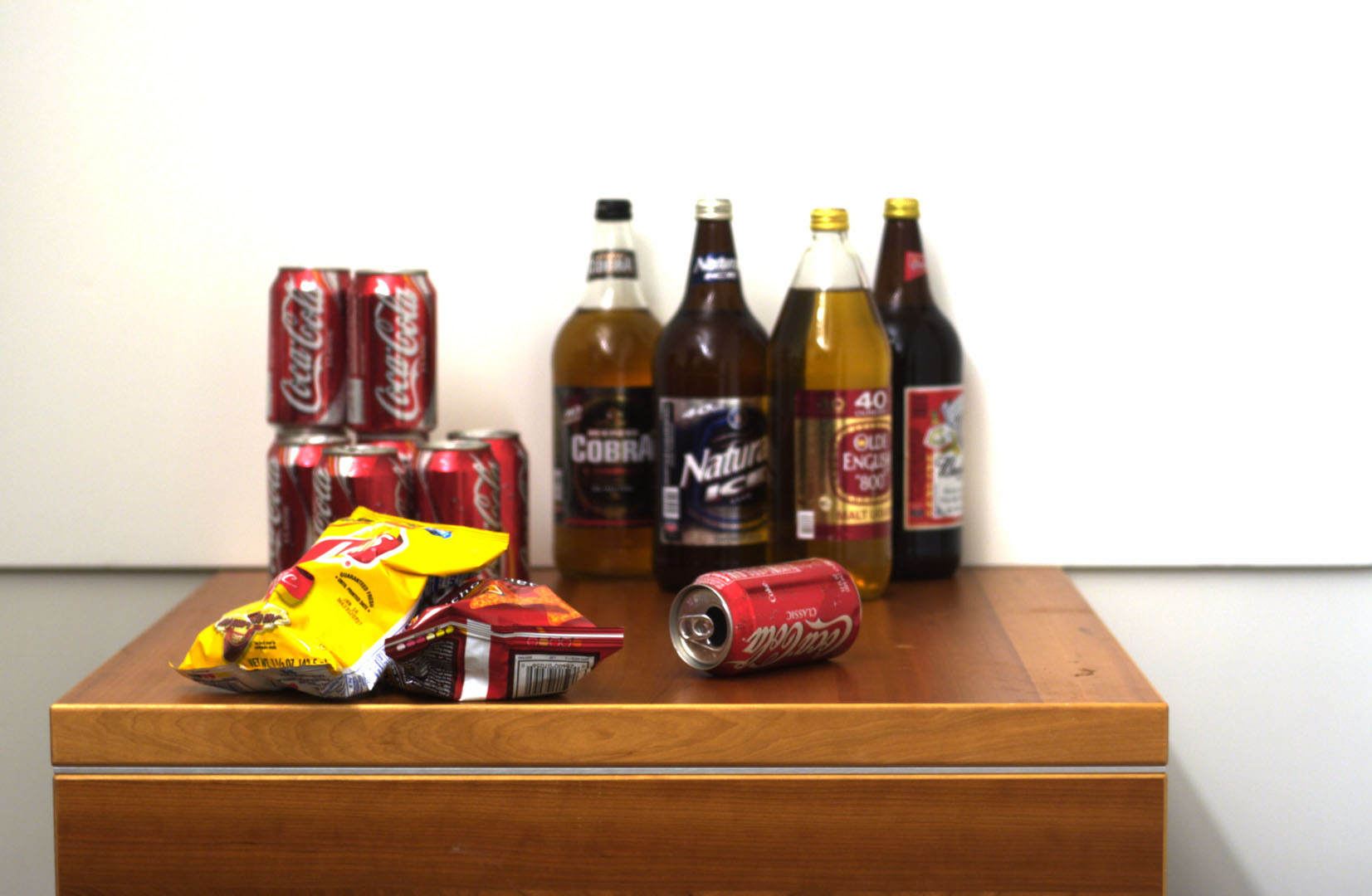“Image and depth from a conventional camera with a coded aperture” by Levin, Fergus, Durand and Freeman
Conference:
Type(s):
Title:
- Image and depth from a conventional camera with a coded aperture
Presenter(s)/Author(s):
Abstract:
A conventional camera captures blurred versions of scene information away from the plane of focus. Camera systems have been proposed that allow for recording all-focus images, or for extracting depth, but to record both simultaneously has required more extensive hardware and reduced spatial resolution. We propose a simple modification to a conventional camera that allows for the simultaneous recovery of both (a) high resolution image information and (b) depth information adequate for semi-automatic extraction of a layered depth representation of the image.Our modification is to insert a patterned occluder within the aperture of the camera lens, creating a coded aperture. We introduce a criterion for depth discriminability which we use to design the preferred aperture pattern. Using a statistical model of images, we can recover both depth information and an all-focus image from single photographs taken with the modified camera. A layered depth map is then extracted, requiring user-drawn strokes to clarify layer assignments in some cases. The resulting sharp image and layered depth map can be combined for various photographic applications, including automatic scene segmentation, post-exposure refocusing, or re-rendering of the scene from an alternate viewpoint.
References:
1. Adelson, E. H., and Wang, J. Y. A. 1992. Single lens stereo with a plenoptic camera. IEEE Trans. Pattern Anal. Mach. Intell. 14, 2, 99–106. Google ScholarDigital Library
2. Axelsson, P. 1999. Processing of laser scanner data–algorithms and applications. ISPRS Journal of Photogrammetry and Remote Sensing 54, 138–147.Google ScholarCross Ref
3. Barrett, R., Berry, M., Chan, T. F., Demmel, J., Donato, J., Dongarra, J., Eijkhout, V., Pozo, R., Romine, C., and der Vorst, H. V. 1994. Templates for the Solution of Linear Systems: Building Blocks for Iterative Methods, 2nd Edition. SIAM, Philadelphia, PA.Google Scholar
4. Boykov, Y., Veksler, O., and Zabih, R. 2001. Fast approximate energy minimization via graph cuts. PAMI 23 (Nov), 1222–1239. Google ScholarDigital Library
5. Cathey, W., and Dowski, R. 1995. A new paradigm for imaging systems. Applied Optics 41, 1859–1866.Google Scholar
6. Chaudhuri, S., and Rajagopalan, A. 1999. Depth from defocus: A real aperture imaging approach. Springer-Verlag, New York.Google Scholar
7. Dowski, E. R., and Cathey, W. T. 1994. Single-lens single-image incoherent passive-ranging systems. Applied Optics 33, 6762–6773.Google ScholarCross Ref
8. Farid, H., and Simoncelli, E. P. 1998. Range estimation by optical differentiation. Journal of the Optical Society of America 15, 1777–1786.Google ScholarCross Ref
9. Favaro, P., Mennucci, A., and Soatto, S. 2003. Observing shape from defocused images. Int. J. Comput. Vision 52, 1, 25–43. Google ScholarDigital Library
10. Fenimore, E., and Cannon, T. 1978. Coded aperture imaging with uniformly redundant rays. Applied Optics 17, 337–347.Google ScholarCross Ref
11. Fergus, R., Singh, B., Hertzmann, A., Roweis, S. T., and Freeman, W. 2006. Removing camera shake from a single photograph. ACM Transactions on Graphics, SIGGRAPH 2006 Conference Proceedings, Boston, MA 25, 787–794. Google ScholarDigital Library
12. Georgiev, T., Zheng, K. C., Curless, B., Salesin, D., Nayar, S., and Intwala, C. 2006. Spatio-angular resolution tradeoffs in integral photography. In Rendering Techniques 2006: 17th Eurographics Workshop on Rendering, 263–272. Google ScholarCross Ref
13. Greengard, A., Schechner, Y., and Piestun, R. 2006. Depth from diffracted rotation. Optics Letters 31, 181–183.Google ScholarCross Ref
14. Grossmann, P. 1987. Depth from focus. Pattern Recognition Letters 5, 1 (Jan.), 63–69. Google ScholarDigital Library
15. Hasinoff, S. W., and Kutulakos, K. N. 2006. Confocal stereo. In European Conference on Computer Vision, I: 620–634. Google ScholarDigital Library
16. Hiura, S., and Matsuyama, T. 1998. Depth measurement by the multi-focus camera. In CVPR, IEEE Computer Society, 953–961. Google ScholarDigital Library
17. Jones, D., and Lamb, D., 1993. Analyzing the visual echo: passive 3-D imaging with a multiple aperture camera. Technical Report CIM 93-3, Dept. of Electrical Engineering, McGill University. Google ScholarDigital Library
18. Kundur, D., and Hatzinakos, D. 1996. Blind image deconvolution. IEEE Signal Processing Magazine 13, 3 (May), 43–64.Google Scholar
19. Lai, S.-H., Fu, C.-W., and Chang, S. 1992. A generalized depth estimation algorithm with a single image. IEEE Trans. Pattern Anal. Mach. Intell. 14, 4, 405–411. Google ScholarDigital Library
20. Levin, A., and Weiss, Y. To appear. User assisted separation of reflections from a single image using a sparsity prior. IEEE Transactions on Pattern Analysis and Machine Intelligence. Google ScholarDigital Library
21. Levin, A. 2006. Blind motion deblurring using image statistics. In Advances in Neural Information Processing Systems (NIPS).Google Scholar
22. Levoy, M., Ng, R., Adams, A., Footer, M., and Horowitz, M. 2006. Light field microscopy. ACM Transactions on Graphics 25, 3 (July), 924–934. Google ScholarDigital Library
23. Nayar, S. K., Watanabe, M., and Noguchi, M. 1995. Real-time focus range sensor. In ICCV, 995–1001. Google ScholarDigital Library
24. Ng, R., Levoy, M., Bredif, M., Duval, G., Horowitz, M., and Hanrahan, P. 2005. Light field photography with a handheld plenoptic camera. Stanford University Computer Science Tech Report CSTR 2005-02.Google Scholar
25. Olshausen, B. A., and Field, D. J. 1996. Emergence of simple-cell receptive field properties by learning a sparse code for natural images. Nature 381 (June), 607–609.Google ScholarCross Ref
26. Pentland, A. P. 1987. A new sense for depth of field. IEEE Trans. Pattern Anal. Mach. Intell. 9, 4, 523–531. Google ScholarDigital Library
27. Premaratne, P., and Ko, C. C. 1999. Zero sheet separation of blurred images with symmetrical point spread functions. Signals, Systems, and Computers, 1297–1299.Google Scholar
28. Raskar, R., Agrawal, A., and Tubmlin, J. 2006. Coded exposure photography: Motion deblurring using fluttered shutter. ACM Transactions on Graphics, SIGGRAPH 2006 Conference Proceedings, Boston, MA 25, 795–804. Google ScholarDigital Library
29. Scharstein, D., and Szeliski, R. 2002. A taxonomy and evaluation of dense two-frame stereo correspondence algorithms. Intl. J. Computer Vision 47, 1 (April), 7–42. Google ScholarDigital Library
30. Zhang, L., and Nayar, S. K. 2006. Projection defocus analysis for scene capture and image display. ACM Trans. on Graphics (also Proc. of ACM SIGGRAPH) (Jul). Google ScholarDigital Library




